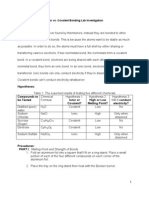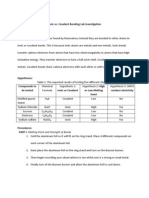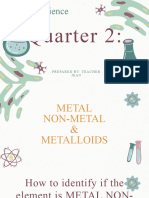Ionic vs. Covalent Bonding Lab Investigation
Ionic vs. Covalent Bonding Lab Investigation
Uploaded by
IngridCopyright:
Available Formats
Ionic vs. Covalent Bonding Lab Investigation
Ionic vs. Covalent Bonding Lab Investigation
Uploaded by
IngridOriginal Title
Copyright
Available Formats
Share this document
Did you find this document useful?
Is this content inappropriate?
Copyright:
Available Formats
Ionic vs. Covalent Bonding Lab Investigation
Ionic vs. Covalent Bonding Lab Investigation
Uploaded by
IngridCopyright:
Available Formats
Ingrid Castillo November 6, 2012 Period 5 Ionic vs.
Covalent Bonding Lab Investigation Introduction: Most atoms are never found themselves instead they are bonded to other atoms in ionic or covalent bonds. This is because atoms need an octet, which means a full shell to be stable. Covalent bonds are molecules, nonmetals, and poor conductors and usually share valence electrons because they have a high electronegativity. Electronegativity is the tendency of an atom or radical to attract electrons in the formation of an ionic bond. In contrast, Ionic bonds are crystals, which are form when a nonmetal and metal bond and also the bond is form because metals have low electronegativity and non-metals have high electronegativity. During the ionic bond, a metal donates electrons to nonmetals, which metals become positively charged (cations) and nonmetals become negatively charged (anion) and create a strong bond. Usually, Ionic bonds can only conduct electricity when is dissolve in water because Ionic substances consist of cations with high effective nuclear charge and anions with low effective nuclear charge, this causes all the electrons in the sigma bond to be pulled towards the cation. Once melted these ions are free to move about. As electricity is defined as a flow of charge, and these charged ions are free to flow about, the resultant melted substance will conduct electricity. Hypotheses: Table 1: The expected results of testing five different chemicals Compounds to Chemical Hypothesis 1: Hypothesis 2: Hypothesis 3: be Tested Formula Ionic or Covalent High or Low Will it conduct Melting Point? electricity? Distilled (pure) H2O Covalent Low Yes Water Sodium chloride NaCl Ionic High When dissolved
Ingrid Castillo November 6, 2012 Period 5 Sucrose (sugar) Dextrose Sodium sulfate C12H22O11 C6H12O6 NaSO4 Covalent Covalent Ionic Low Low High No No Yes
Procedures: PART I. Melting Points and Strengths of Bonds 1. Aluminum foil was neatly folded on the ring-stand. Then a small sample of each of the 4 different compounds was place on the square of aluminum foil and carefully not mixing the compounds. 2. The aluminum was placed on the tray and then on the right stand and was heated with the Bunsen burner. 3. Detailed observations were recorded on the tables for the samples that melt and the ones that had strong bonds and which were weak. 4. The square of foil was allowed to cool off and then washed it off into the sink. PART II. Electrical Conductivity 1. A sample of each compound was placed on different well of a well plate. 2. Dry compounds were tested. 3. Distilled water was added to each compound to dissolve the compound. 4. The solutions were then tested for conductivity using the conductivity tester. Observations were recorded. The conductivity was washed with distilled water every time it was used. 5. Results: Name/ Chemical Formula: Table 2: The results of testing five different chemicals PART I: Part II: Conducted Final Conclusion Melting Point Electricity? (Yes/No) (1-5; High, Med. or Ionic or Covalent Dry Dissolved Low?) Bonds? 1= lowest N/A No Covalent =(Already melted) 5= High No Yes Ionic
Distilled (pure) Water/ H2O Sodium Chloride/ NaCl
Ingrid Castillo November 6, 2012 Period 5 Sucrose (sugar)/ C12H22O11 Dextrose/ C6H12O6 Sodium sulfate/ NaSO4 Conclusion After this laboratory, it was concluded that Sodium chloride and Sodium Sulfate were ionic compounds, while Distilled water, Dextrose, and Sucrose were covalent compounds. All of the initial hypotheses were correct except distilled water because this compound doesnt conduct electricity. From the results, the Ionic compounds were those that conducted electricity in water and had high melting points (strong bonds). However, the covalent compounds were those that didnt conducted electricity in water and had low melting points (weak bonds). Ionic bonds are formed from metals cations (+) and non-metals anions (-) so when they dissolve in water, electricity (moving charge) can flow through the solution. Additionally, Ionic bonds are very strong since cations and ions are held firmly in place inside the ionic crystal by electrostatic attraction between positive and negative charges. However, covalent Bonds do not conduct electricity very efficiently because of the weaker bonds. Covalent Bonds are atoms that share valence electrons rather than ionic bonds, in which the atoms may combine and form cations (positive charge when the loss of valence electrons occurs) and anions (negative charge when valence electrons have been gained). Because covalent bonds have much weaker bonds, they are poor conductors of electricity. Also, they have a much lower melting point than the ionic bonds. 2= Low 3= Med. 4= High No No No No No Yes Covalent Covalent Ionic
You might also like
- Electrical Conductivity: Revision Notes On The Topic 'Electrical Conductivity' For Edexcel IGCSE ChemistryDocument16 pagesElectrical Conductivity: Revision Notes On The Topic 'Electrical Conductivity' For Edexcel IGCSE ChemistryDANSTAN GISORENo ratings yet
- Huckel TheoryDocument6 pagesHuckel TheorydilatedNo ratings yet
- A Study of Copper (II) Complexes With Different LigandsDocument3 pagesA Study of Copper (II) Complexes With Different LigandsZul Nazrie50% (6)
- Ionic v. Covalent Bonding Lab InvestigationDocument3 pagesIonic v. Covalent Bonding Lab InvestigationJackelineNo ratings yet
- Larkin Lab ReportDocument3 pagesLarkin Lab ReportChristopherAguilar33% (3)
- 4 Italo Calderon Lab ReportDocument3 pages4 Italo Calderon Lab ReportLeslieNo ratings yet
- Ionic vs. Covalent Bonding Lab InvestigationDocument3 pagesIonic vs. Covalent Bonding Lab InvestigationItaloNo ratings yet
- Bonding Lab RportDocument3 pagesBonding Lab RportMarlynNo ratings yet
- Ionic vs. Covalent Bonding Lab Investigation: HypothesesDocument3 pagesIonic vs. Covalent Bonding Lab Investigation: HypothesesLeslieNo ratings yet
- Christian Lara Lab ReportDocument3 pagesChristian Lara Lab ReportLeslieNo ratings yet
- Ionic vs. Covalent Bonding Lab InvestigationDocument3 pagesIonic vs. Covalent Bonding Lab InvestigationLeslieNo ratings yet
- Ionic vs. Covalent Bonding Lab InvestigationDocument4 pagesIonic vs. Covalent Bonding Lab InvestigationAngelicaNo ratings yet
- Ionic vs. Covalent Bonding Lab InvestigationDocument3 pagesIonic vs. Covalent Bonding Lab InvestigationLeslieNo ratings yet
- Hypothesis:: Compounds To Be Tested Ionic or Covalent High or Low Melting Point? Electricity?Document3 pagesHypothesis:: Compounds To Be Tested Ionic or Covalent High or Low Melting Point? Electricity?LeslieNo ratings yet
- Ionic vs. Covalent Bonding Lab Investigation: Carefully On The Square FoilDocument3 pagesIonic vs. Covalent Bonding Lab Investigation: Carefully On The Square FoilLeslieNo ratings yet
- Ionic vs. Covalent Bonding Lab InvestigationDocument3 pagesIonic vs. Covalent Bonding Lab InvestigationMarcoluisNo ratings yet
- Katia Medina Larkin 2Document3 pagesKatia Medina Larkin 2kmedina2014No ratings yet
- Ionic vs. Covalent Bonding Lab ReportDocument3 pagesIonic vs. Covalent Bonding Lab ReportLeslieNo ratings yet
- Larkin's Lab ReportDocument3 pagesLarkin's Lab ReportRicardoNo ratings yet
- Matthew McClain Lab Report Period 4Document4 pagesMatthew McClain Lab Report Period 4mmcclain2014No ratings yet
- Ionic vs. Covalent Bonding Lab InvestigationDocument3 pagesIonic vs. Covalent Bonding Lab InvestigationLeslieNo ratings yet
- Ionic vs. Covalent Bonding Lab InvestigationDocument3 pagesIonic vs. Covalent Bonding Lab InvestigationLeslieNo ratings yet
- Ionic vs. Covalent Bonding Lab InvestigationDocument3 pagesIonic vs. Covalent Bonding Lab InvestigationLeslieNo ratings yet
- Ionic vs. Covalent Bonding Lab InvestigationDocument3 pagesIonic vs. Covalent Bonding Lab InvestigationitzelNo ratings yet
- Ionic vs. Covalent Bonding Lab InvestigationDocument4 pagesIonic vs. Covalent Bonding Lab InvestigationLeslieNo ratings yet
- Module-Ii Chemical Bonding: General Chemistry CHEM-1001Document193 pagesModule-Ii Chemical Bonding: General Chemistry CHEM-1001Shivansh SharmaNo ratings yet
- Electrolyte and NonDocument7 pagesElectrolyte and NonSuwahono, M.PdNo ratings yet
- Jose Camacho Chem LABDocument3 pagesJose Camacho Chem LABLeslieNo ratings yet
- 4 Sydney CarrollDocument3 pages4 Sydney CarrollLeslieNo ratings yet
- Experiment 5 Dissimilarity Between Ionic and Covalent CompoundsDocument5 pagesExperiment 5 Dissimilarity Between Ionic and Covalent CompoundsNurasyilah YakubNo ratings yet
- Electrolysis 1 TEDocument5 pagesElectrolysis 1 TETom TommmaNo ratings yet
- ELECTROLYTES Mechanics AssignmentDocument4 pagesELECTROLYTES Mechanics Assignmentbighnesh.2006.singhNo ratings yet
- Chemical Bond (ContDocument18 pagesChemical Bond (ContJachinta JuliusNo ratings yet
- Ionic BondDocument6 pagesIonic BondDivyashri ShendeNo ratings yet
- 8 Thhourlab 9 BakerbrunatikallalkaneoberlanderDocument5 pages8 Thhourlab 9 Bakerbrunatikallalkaneoberlanderapi-297169088No ratings yet
- Chemical BondingDocument87 pagesChemical BondingMichael Dela Torre Diaz Jr.No ratings yet
- Comparing Covalent and Ionic Lattices S4Document3 pagesComparing Covalent and Ionic Lattices S4Fatima Ahmed-VeriterNo ratings yet
- Grade 11 Chapter 4 ChemistryDocument13 pagesGrade 11 Chapter 4 ChemistryKallee BenedictNo ratings yet
- Chemical Bonding IIDocument7 pagesChemical Bonding IIdanielmahsaNo ratings yet
- Ionic vs. Covalent Bonding Lab InvestigationDocument2 pagesIonic vs. Covalent Bonding Lab InvestigationLeslieNo ratings yet
- Lab 4 ReportDocument5 pagesLab 4 Reportaadi.nitin.deNo ratings yet
- X Chem Master Key Differences 22 - 23Document30 pagesX Chem Master Key Differences 22 - 23Prerna JainNo ratings yet
- (C1) Chemical Bond LabDocument2 pages(C1) Chemical Bond Lababdelrahmanadelm2008No ratings yet
- Electrochemistry and ElectrolysisDocument42 pagesElectrochemistry and ElectrolysisAnthonya KnightNo ratings yet
- Al Ittihad Private School Jumeira Science Department 2021/2022Document4 pagesAl Ittihad Private School Jumeira Science Department 2021/2022budoorNo ratings yet
- Shapes of Molecules & Ions: SolubilityDocument2 pagesShapes of Molecules & Ions: SolubilitycomplinotionNo ratings yet
- Class 10 Chemistry Chapter 6 Revision NotesDocument4 pagesClass 10 Chemistry Chapter 6 Revision NotesJackson David JebakumarNo ratings yet
- Structure and BondingDocument37 pagesStructure and Bondingalexia.farrellNo ratings yet
- POC Electrolysis Lab Report1Document8 pagesPOC Electrolysis Lab Report1nityaNo ratings yet
- LABREPORT1Document6 pagesLABREPORT1julinka beyla yansonNo ratings yet
- Chapter 5 Chemical BondDocument8 pagesChapter 5 Chemical Bondمسنيزواتي محمد نورNo ratings yet
- Lec 1. Electrolytes-1Document28 pagesLec 1. Electrolytes-1Falak SherNo ratings yet
- (C1) Chemical Bond LabDocument3 pages(C1) Chemical Bond Lababdelrahmanadelm2008No ratings yet
- Chemistry-Ionic and Covalent BondingDocument2 pagesChemistry-Ionic and Covalent Bondingifaitchwould2No ratings yet
- 3.2 Covalent BondDocument55 pages3.2 Covalent Bond陈凯雯No ratings yet
- GCSE Chemistry Revision: Cheeky Revision ShortcutsFrom EverandGCSE Chemistry Revision: Cheeky Revision ShortcutsRating: 4.5 out of 5 stars4.5/5 (3)
- The Romance of War Inventions: A Description of Warships, Guns, Tanks, Rifles, Bombs, and Other Instruments and Munitions of Warfare, How They Were Invented & How They Are EmployedFrom EverandThe Romance of War Inventions: A Description of Warships, Guns, Tanks, Rifles, Bombs, and Other Instruments and Munitions of Warfare, How They Were Invented & How They Are EmployedNo ratings yet
- Practice Makes Perfect in Chemistry: Chemical BondingFrom EverandPractice Makes Perfect in Chemistry: Chemical BondingRating: 5 out of 5 stars5/5 (3)
- Children Encyclopedia Chemistry: The World of KnowledgeFrom EverandChildren Encyclopedia Chemistry: The World of KnowledgeRating: 5 out of 5 stars5/5 (3)
- Combining Chemicals - Fun Chemistry Book for 4th Graders | Children's Chemistry BooksFrom EverandCombining Chemicals - Fun Chemistry Book for 4th Graders | Children's Chemistry BooksNo ratings yet
- Quiz - Bonding A KEYDocument3 pagesQuiz - Bonding A KEYManongdo Allan100% (1)
- KMT Presentation of ChemistryDocument27 pagesKMT Presentation of ChemistrySyed Zubair ZahidNo ratings yet
- Chem 120 Exam ReviewDocument10 pagesChem 120 Exam ReviewRazan AliNo ratings yet
- Hydrogen BondDocument21 pagesHydrogen BondWidya FatmawatiNo ratings yet
- Hydrogen Atom: Duplet Electron ArrangementDocument3 pagesHydrogen Atom: Duplet Electron Arrangementcar_yiiNo ratings yet
- 2nd QTR MOD. 1 DLLDocument191 pages2nd QTR MOD. 1 DLLleiziah xyrille maturanNo ratings yet
- Ions and Ionic Bonding Pre-AICEDocument4 pagesIons and Ionic Bonding Pre-AICEKelsey MarieNo ratings yet
- Unit 4 Chemical Bonding & Molecular StructureDocument29 pagesUnit 4 Chemical Bonding & Molecular StructureVighnesh0% (1)
- Unit 3 Test Review AnswersDocument2 pagesUnit 3 Test Review Answersapi-266061131100% (1)
- 3.091 - Introduction To Solid State Chemistry Lecture Notes No. 2 Chemical BondingDocument34 pages3.091 - Introduction To Solid State Chemistry Lecture Notes No. 2 Chemical BondingFeliciaPutriNo ratings yet
- Inorganic Chemistry Lecture - 1Document13 pagesInorganic Chemistry Lecture - 1Wanderson Alves PortoNo ratings yet
- 5.3 (A) Covalent Bond MeaningDocument33 pages5.3 (A) Covalent Bond MeaningFidree AzizNo ratings yet
- ATOMIC BONDING - Ionic BondDocument15 pagesATOMIC BONDING - Ionic BondSarahNo ratings yet
- Lennard-Jones PotentialDocument4 pagesLennard-Jones PotentialNaveenDarwin0% (1)
- 4 1 - Atomic Theory BondingDocument38 pages4 1 - Atomic Theory Bondingapi-309810985No ratings yet
- Chem 121 Problem Set V Lewis Structures, VSEPR and Polarity AnswersDocument10 pagesChem 121 Problem Set V Lewis Structures, VSEPR and Polarity AnswersMauro VanNo ratings yet
- Electron Withdrawing and Electron Donating GroupsDocument2 pagesElectron Withdrawing and Electron Donating GroupsOmar Abd ElsalamNo ratings yet
- Superacid PresentationDocument14 pagesSuperacid PresentationTushar TanejaNo ratings yet
- Valence Shell Electron Pair Repulsion TheoryDocument16 pagesValence Shell Electron Pair Repulsion TheoryUnnati SinariNo ratings yet
- K. Schofield PH.D., D.SC., F.R.I.C. (Auth.) - Hetero-Aromatic Nitrogen Compounds - Pyrroles and Pyridines-Springer US (1967) PDFDocument439 pagesK. Schofield PH.D., D.SC., F.R.I.C. (Auth.) - Hetero-Aromatic Nitrogen Compounds - Pyrroles and Pyridines-Springer US (1967) PDFMari Medeiros0% (1)
- Molecular Geometry: Vsepr Valence Bond Theory Molecular Orbital TheoryDocument44 pagesMolecular Geometry: Vsepr Valence Bond Theory Molecular Orbital TheoryAnonymous AEt3M9TNo ratings yet
- Quiz 02Document4 pagesQuiz 02honey1002No ratings yet
- Oforgan, 9.: Invited ReviewDocument22 pagesOforgan, 9.: Invited Reviewfiery punctuationNo ratings yet
- Introduction To Organic Chemistry: of Chemical Bonding FundamentalsDocument7 pagesIntroduction To Organic Chemistry: of Chemical Bonding FundamentalsmuhammadyousufkhanNo ratings yet
- PolarityDocument22 pagesPolarityEvangelene Esquillo SanaNo ratings yet
- HW 10 20190827092946 1Document2 pagesHW 10 20190827092946 1Jaskirat SinghNo ratings yet
- Chemistry Test 2: Date: 24/09/2020 Day: Thursday Topics/Chapters InvolvedDocument2 pagesChemistry Test 2: Date: 24/09/2020 Day: Thursday Topics/Chapters InvolvedRXNOFCHMNo ratings yet
- General Organic Chemistry: (A) Inductive EffectDocument44 pagesGeneral Organic Chemistry: (A) Inductive EffectHarsh TyagiNo ratings yet

























































































